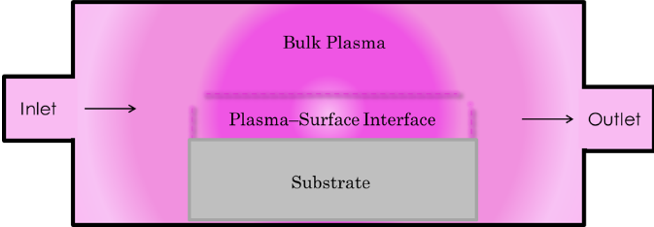

Research in the Blechle Research Group involves investigating the chemical behavior of artificial plasmas. These systems are utilized for a variety of applications, including semiconductor design, modification of biomaterials, and advanced catalysis. Much of the underlying chemistry of these plasmas, despite the far-reaching impacts, remains unknown. As such, we are ultimately interested in investigating these systems to provide insight into the type of reactions that occur and how the reactor design can influence the energetics of the plasma itself. The approach is two-fold: (1) understand the fundamental chemistry of gas-phase species produced in non-thermal plasmas (NTPs) by different precursor gas sources and the role that plasma parameters (applied power, precursor flow rate, etc.) have on gas-phase composition; and (2) investigate the behavior of these species when in contact with substrates to establish trends in surface-mediated reactions and the means by which they occur. To fully understand these environments, we must investigate the distinct regions of the system highlighted in the figure below:

Fig. 1. A representation of a plasma reactor cross-section, highlighting the three distinct regions of interest for this work: the plasma bulk, the substrate, and the region in which these two distinct systems interact with one another.
Within the plasma bulk, there are several metrics by which to evaluate the species present. Additionally, there are a number of characteristic energies that can be monitored within plasmas, including translational, rotational and vibrational temperature (TT, TR and TV, respectively) of the non-ionized species. Evaluating these temperatures provides insight into the complex energetic environment of the system and can be used to elucidate the mechanisms of species formation and evaluation of the system's non-equilibrium nature. Indeed, determining these temperatures is the primary focus of the plasma diagnostic efforts. Of primary importance in this work is the use of optical emission spectroscopy (OES), allowing for in situ measurements of excited state species present within the plasma system. These species can be generated by any number of reactions; some primary examples are listed below (for the generic molecule XY):
Each of the measureable quantities of bulk plasmas (TT, TR and TV) can be sensitive to the parameter space (and can be additionally influenced by the presence of a substrate within the system, leading to a host of surface-mediation reactions. Indeed, the bulk of plasma applications involve etching, deposition, or surface modification, whereas some systems utilize gas-surface interactions to influence the downstream chemistry of resulting gas phase species. Whether these species are involved in adsorption/desorption mechanisms, molecule-surface quenching, or a combination thereof, is of significant importance in furthering our understanding of these systems. While there is much to be learned about the nature of these reactions, it is certain that the choice of substrate can significantly alter the energy of the plasma itself whereas the choice of precursor(s) can significantly impact the chemistry of the surface, resulting in an interconnected system of plasma-surface reactions and mechanisms. This can be seen in the comparison of rotational temperatures with and without a substrate present.

Fig. 2. Data points represent internal temperatures determined for NO in the presence of a silicon substrate as a function of applied power. Ground state (purple) and excited state (orange) species were formed in a 100 mTorr NO plasma. Dashed lines represent lines of best fit for data collected under identical conditions, without the presence of a substrate.
(1) Plasma-Assisted Catalysis:
In this project, our work focuses on exploring the fundamental chemistry that governs the catalytic conversion of NxOy species. We have been synthesizing Al2O3 catalysts doped with various precious metals and are exploring the impact they have on plasmas formed from model exhaust gases. By monitoring species temperatures, species densities, and reaction kinetics, we are able to explore the mechanisms that control successful conversion of harmful combustion byproducts.
(2) Thin Film Modification:
In this project, our work focuses on exploring the mechanisms that govern plasma-enhanced surface modification of natural polymers. Thin films formed from natural fibers are being synthesized for biomedical applications, but widespread use is limited by irregularities in the resulting materials. By monitoring the underlying chemistry of these systems, we hope to provide insight on how to achieve desirable modifications in a reliable manner.